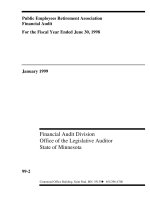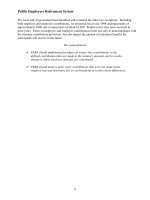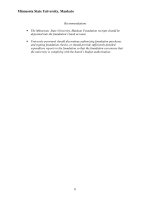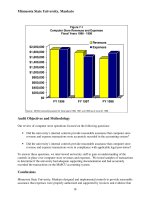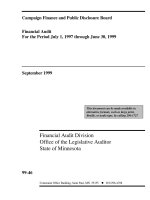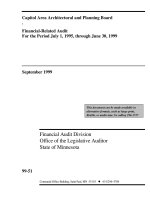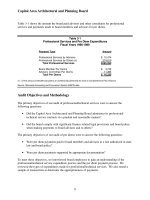Campaign Finance and Public Disclosure Board Financial Audit For the Period July 1, 1997 through June 30, 1999_part1 pptx
Bạn đang xem bản rút gọn của tài liệu. Xem và tải ngay bản đầy đủ của tài liệu tại đây (221 KB, 11 trang )
Campaign Finance and Public Disclosure Board
Financial Audit
For the Period July 1, 1997 through June 30, 1999
September 1999
Financial Audit Division
Office of the Legislative Auditor
State of Minnesota
99-46
Centennial Office Building, Saint Paul, MN 55155 651/296-4708
This document can be made available in
alternative formats, such as large print,
Braille, or audio tape, by calling 296-1727
SUMMARY
State of Minnesota
Office of the Legislative Auditor
1st Floor Centennial Building
658 Cedar Street • St. Paul, MN 55155
(651)296-1727 • FAX (651)296-4712
TDD Relay: 1-800-627-3529
email:
URL:
Campaign Finance and Public Disclosure Board
Financial Audit
For the Period July 1, 1997, through June 30, 1999
Public Release Date: September 2, 1999 No.99-46
Agency Background
The Legislature established the Ethical Practices Board in 1974, as part of the Ethics in
Government Act, under Minnesota Statute Chapter 10A. (Effective in July 1997 the Legislature
changed the board’s name to the Campaign Finance and Public Disclosure Board to better
describe its responsibilities.) The Governor appoints the six-member board to staggered four-
year terms, with the advice and three-fifths consent of the Senate and House of Representatives.
The board appointed Jeanne Olson as the executive director in July 1995.
The Campaign Finance and Public Disclosure Board is the service and regulatory agency that:
• enforces state laws requiring the disclosure of public and local officials' financial
interests and potential conflicts of interest;
• oversees and enforces state laws for the disclosure of lobbying expenditures to influence
state legislative, administrative, and official actions of governmental units;
• reviews, monitors, and compiles receipts and expenditures reported by political parties,
campaign committees, and political funds for compliance with disclosure law
requirements and adherence to applicable expenditure limits; and
• administers the State Elections Campaign fund distributions to qualified state candidates
and the state committees of political parties.
The board receives state appropriations for its operational activities.
Audited Areas and Conclusions
Our audit scope included the State Elections Campaign Fund and payroll and per diem
expenditures for the period from July 1, 1997, to June 30, 1999.
We concluded that the Campaign Finance and Public Disclosure Board properly recorded,
allocated, and distributed State Elections Campaign funds to eligible candidates and state
committees of political parties. In addition, for the items tested, the board complied with
material finance-related legal provisions for the State Elections Campaign fund.
We concluded that the Campaign Finance and Public Disclosure Board accurately recorded
payroll and per diem expenditures in the accounting records. In addition, for the items tested, the
board complied with applicable statutory provisions and bargaining unit agreements.
STATE OF MINNESOTA
OFFICE OF THE LEGISLATIVE AUDITOR
JAMES R. NOBLES, LEGISLATIVE AUDITOR
Representative Dan McElroy, Chair
Legislative Audit Commission
Members of the Legislative Audit Commission
Ms. Sidney Pauly, Chair
Campaign Finance and Public Disclosure Board
Ms. Jeanne Olson, Executive Director
Campaign Finance and Public Disclosure Board
We have audited the Campaign Finance and Pubic Disclosure Board for the period July 1, 1997,
through June 30, 1999, as further explained in the report. Our audit scope focused on the
disbursement of State Elections Campaign Fund monies to candidates and political parties, and
payroll and per diem expenditures. The attached Summary highlights the audit objectives and
conclusions. We more fully discuss the audit objectives and conclusions in the chapters of this
report.
We conducted our audit in accordance with generally accepted auditing standards and
Government Auditing Standards, as issued by the Comptroller General of the United States.
Those standards require that we design the audit to provide reasonable assurance that the
Campaign Finance and Public Disclosure Board complied with provisions of laws, regulations,
contracts, and grants that are significant to the objectives of the audit. The management of the
Campaign Finance and Public Disclosure Board is responsible for establishing and maintaining the
internal control structure and ensuring compliance with applicable laws, regulations, contracts,
and grants.
This report is intended for the information of the Legislative Audit Commission and the
management of the Campaign Finance and Public Disclosure Board. We do not, however, limit
the distribution of this report, which was released as a public document on September 2, 1999.
We thank the Campaign Finance and Public Disclosure Board staff for their cooperation during
this audit.
James R. Nobles Claudia J. Gudvangen, CPA
Legislative Auditor Deputy Legislative Auditor
End of Fieldwork: August 6, 1999
Report Signed On: August 30, 1999
1ST FLOOR SOUTH, CENTENNIAL BUILDING 658 CEDAR STREET ST. PAUL, MN 55155
TELEPHONE 651/296-4708 TDD RELAY 651/297-5353 FAX 651/296-4712 WEB SITE
Campaign Finance and Public Disclosure Board
Table of Contents
Page
Chapter 1. Introduction 1
Chapter 2. The State Elections Campaign Fund 2
Chapter 3. Payroll and Per Diem Expenditures 5
Status of Prior Audit Issues 7
Audit Participation
The following members of the Office of the Legislative Auditor prepared this report:
Claudia Gudvangen, CPA Deputy Legislative Auditor
Cecile Ferkul, CPA, CISA Audit Manager
Jason Stauffenecker Auditor-in-Charge
Exit Conference
We discussed the results of the audit at an exit conference with the following staff from the
Campaign Finance and Public Disclosure Board on August 24, 1999:
Jeanne Olson Executive Director
Gary Goldsmith Assistant Executive Director
Luann Swanson Office Supervisor
Campaign Finance and Public Disclosure Board
1
Chapter 1. Introduction
The Legislature established the Ethical Practices Board in 1974, as part of the Ethics in
Government Act, under Minnesota Statute Chapter 10A. (Effective in July 1997 the Legislature
changed the board’s name to the Campaign Finance and Public Disclosure Board to better
describe its responsibilities.) The Governor appoints the six-member board to staggered four-
year terms, with the advice and three-fifths consent of the Senate and the House of
Representatives. The board’s membership represents various political parties, as established in
statute. The board appointed Jeanne Olson as the executive director in July 1995.
The primary mission of the board is to promote public confidence in state government decisions
through timely compliance with disclosure and public financing laws, and by developing
programs that will ensure public access to information filed with the board.
The Campaign Finance and Public Disclosure Board performs the following functions:
• enforces state laws requiring the disclosure of public and local officials' financial
interests and potential conflicts of interest;
• oversees and enforces state laws for the disclosure of lobbying expenditures to influence
state legislative, administrative, and official actions of governmental units;
• reviews, monitors, and compiles receipts and expenditures reported by political parties,
campaign committees, and political funds for compliance with disclosure law
requirements and adherence to applicable expenditure limits; and
• administers the State Elections Campaign Fund distributions to qualified state candidates
and the state committees of political parties.
The board received an appropriation of $593,000 in fiscal year 1998 and $483,000 in fiscal year
1999 for operational expenses.
Table 1-1 shows the expenditures of the Campaign Finance and Public Disclosure Board for the
two years ended June 30, 1999.
Table 1-1
Campaign Finance and Public Disclosure Board Expenditures
July 1, 1997 - June 30, 1999
Disbursement Type Fiscal Year 1998 Fiscal Year 1999 Total
State Elections Campaign Fund $ 98,589 $3,993,277 $4,091,866
Payroll and Per Diems 378,384 384,305 762,688
Other (1) 155,659 121,323 276,982
Total $632,631 $4,498,905 $5,131,536
Note (1) For the fiscal year 1998 and 1999 period, the Legislature appropriated $122,000 for the board to improve its computer
operations. The “Other” category includes the purchase of computer equipment and system development costs.
Although the costs occurred in both fiscal years, a higher percentage occurred in fiscal year 1998.
Source: Minnesota Accounting and Procurement System.
Campaign Finance and Public Disclosure Board
2
Chapter 2. The State Elections Campaign Fund
Chapter Conclusions
The Campaign Finance and Public Disclosure Board properly recorded,
allocated, and distributed State Elections Campaign Fund monies to eligible
candidates and state committees of political parties. For the items tested, the
board complied with legal provisions applicable to the State Elections
Campaign Fund.
The Campaign Finance and Public Disclosure Board administers the State Elections Campaign
Fund. The fund provides grants as an alternative source of campaign financing to lessen the
reliance of candidates on large contributors and limit the overall spending for election
campaigns.
Grants are available to state constitutional office candidates and state legislative candidates who
meet statutory eligibility requirements, and to state committees of political parties to assist with
expenditures, such as general advertising and conducting sample ballots. To qualify for a grant
from the State Elections Campaign Fund, a candidate had to file with the board, establish a
campaign committee, and file a Public Subsidy Agreement (which states the candidate will abide
by campaign limits), and an Affidavit of Contribution. In addition, a candidate had to appear on
the general election ballot to be eligible for party account funds, and had to receive a minimum
percent of the vote in the general election to be eligible for general account funds.
Prior to 1996, only the Democratic-Farmer-Labor (DFL) party and the Republican Party of
Minnesota met the eligibility requirements for these grants. Since January 1996, the board also
paid grants to the Reform Party of Minnesota, the Grassroots Party, and the Libertarian Party,
when those parties also met the grant requirements.
The State Elections Campaign Fund receives most of its funding from the state’s General Fund
based on taxpayers’ designations on their state tax returns. Each taxpayer can designate that the
state’s General Fund provide $5 either to the account of a political party or to the State Elections
Campaign Fund’s general account. The Department of Revenue certifies to the board the
amount of the taxpayer designations, less three percent that the state’s General Fund retains to
offset administrative costs. In addition to taxpayer designations, the Legislature also
appropriated to the State Elections Campaign Fund’s general account $1.5 million for each
general election. Statutes allow the board to carry forward funds allocated to offices not up for
election (and thus unused) and any taxpayer designations certified by the Department of Revenue
after the board disbursed grants. Finally, the board may accept anonymous contributions or
donations, which it deposits into the general account. Table 2-1 summarizes the funding from
these various sources for fiscal years 1998 and 1999.
Campaign Finance and Public Disclosure Board
3
Table 2-1
State Elections Campaign Fund
Sources of Funding for the 1998 Elections
Account
Taxpayer
Check-off
Appropriations
Carry
Forward (1)
Misc.
Receipts
Total
Available
DFL $1,041,170 $ 0 $ 221,839 $ 0 $1,263,009
Republican 819,675 0 203,387 0 1,023,062
Reform 74,150 0 10,116 0 84,266
Grass Roots 80,990 0 9,096 0 90,086
Libertarian 51,830 0 3,491 0 55,321
General Account 661,710 1,500,000 690,573 $790 2,853,073
Total $2,729,525 $1,500,000 $1,138,502 $790 $5,368,817
Note (1): The board carried forward funds from the 19 96 election that had been allocated to offices not up for election in November
1996 and additional taxpayer designations certified by the Department of Revenue after the board disbursed grants.
Source: Minnesota Accounting and Procurement System and Depar tment of Revenue Certifications.
According to statute, the board distributes political party account funds to eligible candidates
based on the designations made by the taxpayers within the candidates’ constituencies. The
board distributes general account funds to all eligible candidates (for each type of office) equally.
The board reallocated funds to the state committee of a party if an eligible candidate was
unopposed in both the primary and general elections. Table 2-2 shows the allocation of public
grant funds for each account.
Table 2-2
State Elections Campaign Fund
Allocations For the 1998 Elections
Account
Retained
by the
General
Fund (1)
Disbursed
to
Candidates
Disbursed
to
Parties
Carried
Forward (2)
Returned
to
General
Fund (3)
Total
DFL $31,235 $ 854,665 $100,993 $242,222 $ 33,894 $1,263,009
Republican 24,590 689,212 101,455 192,832 14,972 1,023,060
Reform 2,225 18,767 7,419 23,431 32,651 84,493
Grass Roots 2,430 0 7,856 0 79,800 90,086
Libertarian 1,555 142 5,028 0 48,596 55,321
General Account 19,851 2,328,774 0 504,223 0 2,852,848
Total $81,886 $3,891,560 $222,751 $962,708 $209,914 $5,368,817
Notes:
(1) By statute, the state’s General Fund retains three percent of the funds designated by taxpayers.
(2) The board carried forward funds to the 2000 election that had been allocated to offices not up for election in November
1998 and additional taxpayer designations certified by the Department of Revenue after the board disbursed grants.
(3) The board returned funds to the state’s General Fund if a political party did not have an eligible candidate for an office.
Source: Minnesota Accounting and Procurement Syste m and Department of Revenue Certifications.
After it disbursed all grants, the board reviewed candidates' expenditure reports to determine if
candidates had to return any of the grant funds received. State statutes require a candidate to
return all or a portion of a grant when the amount of a grant received exceeded the total
Campaign Finance and Public Disclosure Board
4
campaign expenditures or when funds that remained in a candidate's campaign committee
account exceeded the maximum statutory amount. The board deposits returned funds in the
state’s General Fund. For the 1998 election, candidates returned nearly $50,000.
Audit Objectives and Methodology
The objectives of our review of the State Elections Campaign Fund were as follows:
• Did the Campaign Finance and Public Disclosure Board properly allocate and disburse
State Elections Campaign Fund monies to eligible candidates and state committees of
political parties, and did it accurately report those expenditures in the accounting records?
• Did the Campaign Finance and Public Disclosure Board comply with statutory
requirements for the State Elections Campaign Fund?
To meet these objectives, we interviewed board employees to gain an understanding of controls
over the State Elections Campaign Fund. We analyzed and reviewed taxpayer designations
certified by the Minnesota Department of Revenue. We determined whether the board properly
allocated funds to each account, properly carried forward funds to the next general election, and
properly returned funds to the state’s General Fund. We also reviewed documentation for a
sample of candidates who received grants to verify that the board properly determined the
candidates’ eligibility, properly calculated the grant amounts, paid the grants from the correct
account, and determined whether the candidates had to return any of the grant funds. Finally, we
reviewed grant payments to state committees of political parties to determine if the board
properly allocated and distributed those grant funds.
Conclusions
The Campaign Finance and Public Disclosure Board properly recorded, allocated, and
distributed State Elections Campaign Fund monies to eligible candidates and state committees of
political parties. In addition, for the items tested, the board complied with legal provisions
applicable to the State Elections Campaign Fund.
Campaign Finance and Public Disclosure Board
5
Chapter 3. Payroll and Per Diem Expenditures
Chapter Conclusions
The Campaign Finance and Public Disclosure Board accurately reported
payroll and per diem expenditures in the accounting system. The board
complied with applicable statutory provisions and bargaining unit agreements
for the items tested.
Payroll and per diem expenditures were the Campaign Finance and Public Disclosure Board’s
largest type of administrative expenditure. The board had eight full-time employees and, for part
of the audit period, one intermittent, part-time employee. During fiscal year 1998 and 1999, the
board paid its employees approximately $375,000 and $381,000 respectively. The following
organizations represented the board's employees:
• The Managerial Plan,
• The Middle Management Association (MMA),
• The Minnesota Association of Professional Employees (MAPE), and
• The American Federation of State, County, and Municipal Employees (AFSCME).
The board’s six board members received per diems of $55 for time spent on board activities. In
addition to monthly board meetings, the board occasionally held special meetings with
legislators or other organizations. During fiscal years 1998 and 1999, the board members
received per diem payments totaling $6,380.
Audit Objectives and Methodology
The objectives of our review of payroll and per diem expenditures were as follows:
• Did the Campaign Finance and Public Disclosure Board accurately record payroll and per
diem expenditures in the accounting records?
• Did the board's payroll and per diem expenditures comply with applicable statutory
provisions and bargaining agreements?
To meet these objectives, we interviewed board employees to gain an understanding of controls
over payroll and per diems, and we reviewed supporting documentation. We reviewed personnel
transactions and employee pay rates to determine if the board complied with statutory provisions
and bargaining agreements.
Campaign Finance and Public Disclosure Board
6
Conclusions
We concluded that the board accurately recorded payroll and per diem expenditures in the
accounting records. We also concluded that the board complied with applicable statutory
provisions and bargaining agreements for the items tested.
Campaign Finance and Public Disclosure Board
7
Status of Prior Audit Issues
As of August 6, 1999
Most Recent Audit
Legislative Audit Report 97-51, issued in September 1997, covered the two fiscal years ended
June 30, 1997. The audit scope included State Election Campaign Fund grants, and payroll and
per diem expenditures. The report did not include any findings related to the Campaign Finance
and Public Disclosure Board.
State of Minnesota Audit Follow-Up Process
The Department of Finance, on behalf of the Governor, maintains a quarterly process for following up on issues cited in
financial audit reports issued by the Legislative Auditor. The process consists of an exchange of written correspondence
that documents the status of audit findings. The follow-up process continues until Finance is satisfied that the issues have
been resolved. It covers entities headed by gubernatorial appointees, including most state agencies, boards, commissions,
and Minnesota state colleges and universities. It is not applied to audits of the University of Minnesota, any quasi-state
organizations, such as the metropolitan agencies or the State Agricultural Society, the state constitutional officers, or the
judicial branch.

